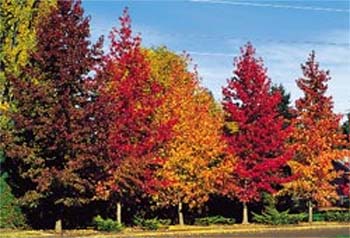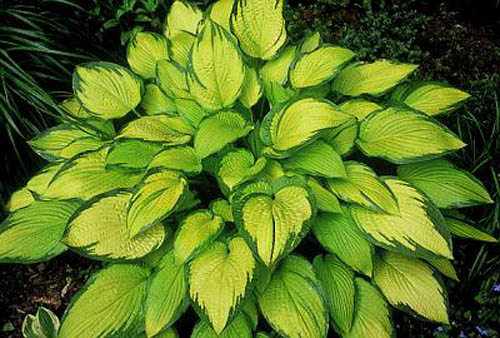We have never seen a tree that we did not like. There is probably one out there but we have yet to find it. We continually see trees that we “ just have to have” in our garden which leads us into this months Yard Talk. Since we cannot physically grow all of these trees lets at least talk about the ones we wish we had.
 Cinnamomum camphora ”Camphor Tree or Gum Camphor” is a dense broad leaved evergreen that is capable of growing 50-150 feet tall and spreading twice that wide with a trunk up to 15 feet in diameter. Camphor is widely planted as a shade tree, screen, or windbreak and is a sturdy storm resistant tree. The shiny foliage is made up of alternate 1-4 inch oval leaves dangling from long petioles. Each leaf has three distinct yellowish veins. The outer margins of the leaves tend to be somewhat wavy and turn upward. The new foliage starts out a rusty burgundy color, but the leaves soon turn dark green on the upper sides and paler green underneath. Camphor tree can be readily identified by the distinctive odor of a crushed leaf. Camphor tree also is a larval food source for the spicebush swallowtail butterfly. Unfortunately, these desirable traits are offset by the tree’s invasiveness and damaging effects on wildlife and natural communities. It has been shown to cause sterility in birds.
Cinnamomum camphora ”Camphor Tree or Gum Camphor” is a dense broad leaved evergreen that is capable of growing 50-150 feet tall and spreading twice that wide with a trunk up to 15 feet in diameter. Camphor is widely planted as a shade tree, screen, or windbreak and is a sturdy storm resistant tree. The shiny foliage is made up of alternate 1-4 inch oval leaves dangling from long petioles. Each leaf has three distinct yellowish veins. The outer margins of the leaves tend to be somewhat wavy and turn upward. The new foliage starts out a rusty burgundy color, but the leaves soon turn dark green on the upper sides and paler green underneath. Camphor tree can be readily identified by the distinctive odor of a crushed leaf. Camphor tree also is a larval food source for the spicebush swallowtail butterfly. Unfortunately, these desirable traits are offset by the tree’s invasiveness and damaging effects on wildlife and natural communities. It has been shown to cause sterility in birds.
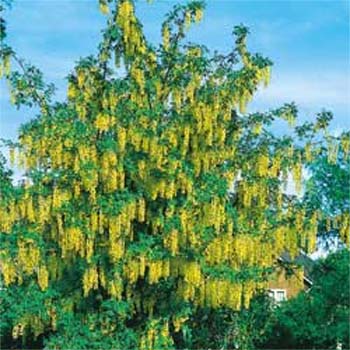 Laburnum watereri ‘Vossii’ Golden Chain Tree has 18-24 inch racemes of golden yellow flowers, resembling Wisteria, transform this Golden Chain Tree into a sparkling cascade. This is one of the best choices for smaller gardens. Magnificent in bloom and handsome all season long with its smooth, bright green bark and lower leaf foliage, this cultivar was selected for its dense habit and extra long flower clusters. Vossii is easily grown in a sheltered position with afternoon shade and well-drained soil. This tree dislikes fertilizer, generating its own nitrogen, and it will do well in poor, dry soil. Do not plant where young children can eat the poisonous seeds.
Laburnum watereri ‘Vossii’ Golden Chain Tree has 18-24 inch racemes of golden yellow flowers, resembling Wisteria, transform this Golden Chain Tree into a sparkling cascade. This is one of the best choices for smaller gardens. Magnificent in bloom and handsome all season long with its smooth, bright green bark and lower leaf foliage, this cultivar was selected for its dense habit and extra long flower clusters. Vossii is easily grown in a sheltered position with afternoon shade and well-drained soil. This tree dislikes fertilizer, generating its own nitrogen, and it will do well in poor, dry soil. Do not plant where young children can eat the poisonous seeds.
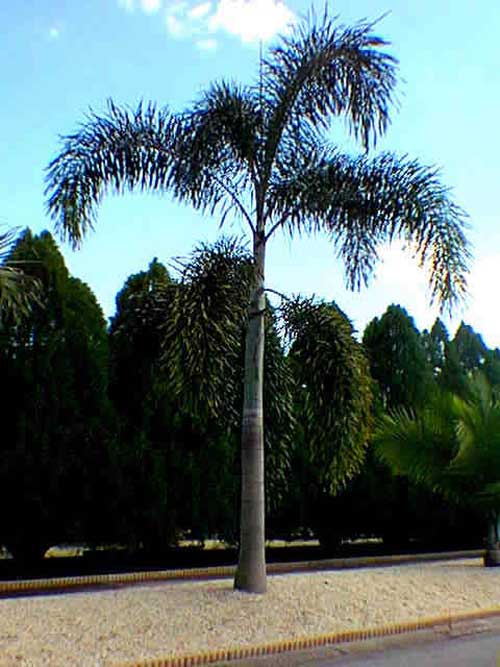 Archontophoenix cunninghamiana ‘King Palm’ has a dramatic effect on large gardens with its single trunk, pinnate frond leaf type 8 – 10 feet in size. Green above gray beneath, each frond is attached to long trunk shaft with dead fronds dropping off on their own.
Archontophoenix cunninghamiana ‘King Palm’ has a dramatic effect on large gardens with its single trunk, pinnate frond leaf type 8 – 10 feet in size. Green above gray beneath, each frond is attached to long trunk shaft with dead fronds dropping off on their own.
The base of the petioles form a greenish-yellow to brown crown-shaft that the leaves rarely droop below. The trunk is smooth and ringed with noticeable leaf scars. Flowers are formed below the crown-shaft with the creamy flower stalks holding mauve flowers. The round green fruit, about 1/2 inch in diameter, turn bright red at maturity. There is often a noticeable bulge in the crown-shaft before the flowers emerge which gives the tree a “pregnant” look.
Some trees we just must dream about! In retrospect we guess this is what makes visiting other parts of the country so much more special.
Tips of the Month
Following are some things to consider when choosing a tree for your home.
- Choose a location, be sure that the location you choose has plenty of room for the tree’s roots to grow.
- Do you want fine leaves, such as on willow trees or do you prefer bold, broad leaves, such as on maple trees?
- While fast-growing shade trees deliver shade quickly, shade trees that grow more slowly may last quite a bit longer.
- Flower and fruit-bearing trees provide beauty, they also require more maintenance.
- If you prefer a low-maintenance tree, choose one accordingly.
- Consider buying an older tree, and then transplant it to your yard.
- Will leaves need to be raked and disposed of?
- Where and at what time of day will the shade be cast?
- Are there any obstructions overhead that your trees grow into?
- How does the location of your tree affect the energy needs of surrounding buildings? Does it provide a windbreak or sun block to reduce energy needs?
What size of tree, shape of the mature canopy, and any other implications for your site all require research on your part before you commit to a variety of tree. Take your time for you are choosing a living plant and making a long term commitment. If you select wrong, you are spelling doom for a living organism.
Flower of the Month
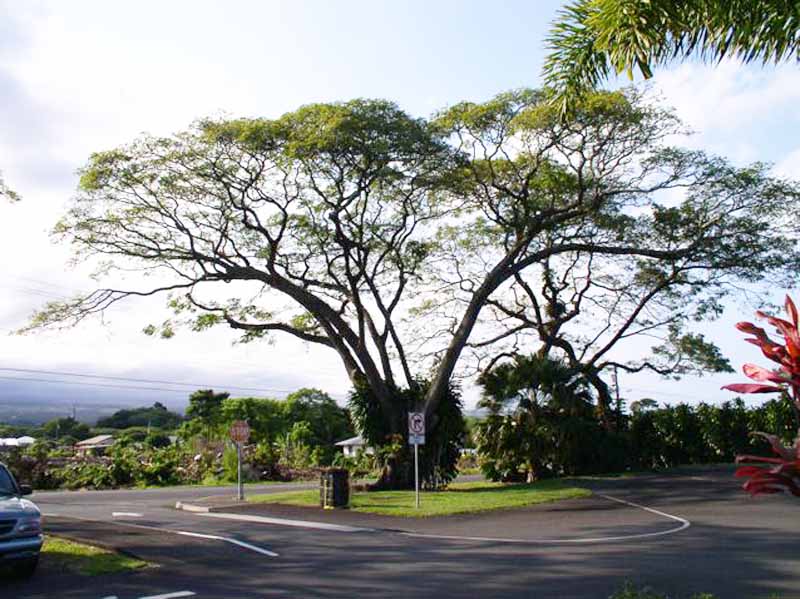
Samanea saman Monkey Pod Tree or Raintree
It is a fast-growing tree that has been introduced to many tropical countries throughout the world from its native habitats in Central America and northern South America. Although generally planted as a shade tree and ornamental, it has been naturalized in many countries and is greatly valued in pastures as shade for cattle. A spreading crown, when grown in the open characterizes this beautiful tree, it forms a long, relatively straight stem when closely spaced. Its wood is highly valued in some locations for carvings and furniture.
Web Site of the Month
The Greenwood Nursery Internet Store
They are part of a family owned and operated wholesale nursery and plant farm. They are located in middle Tennessee in the small city of McMinnville. It all started almost thirty years ago when they planted their first seeds and shrub cuttings. Today, Greenwood Nursery is still dedicated to servicing the needs of their clients. Not only do they ship to their customers, Greenwood Nursery is also a plant fulfillment center for major catalog houses. With resources across the country, we can locate just about any plant material.
